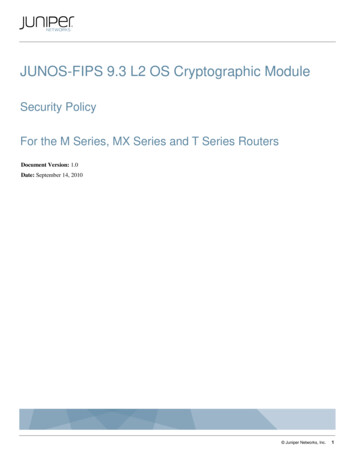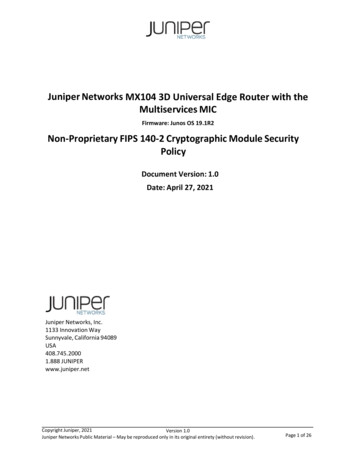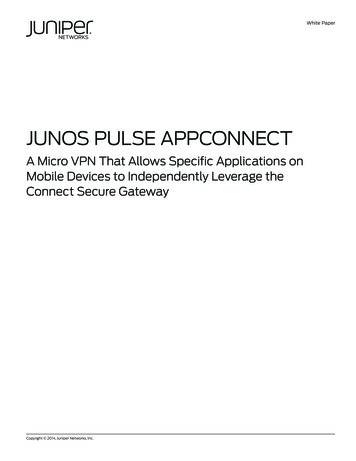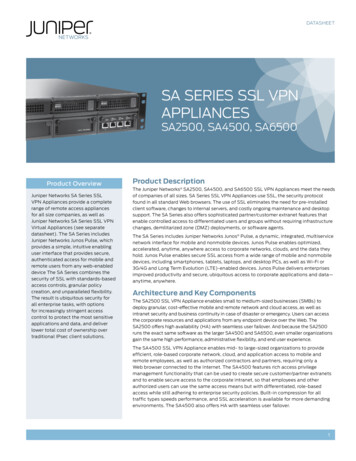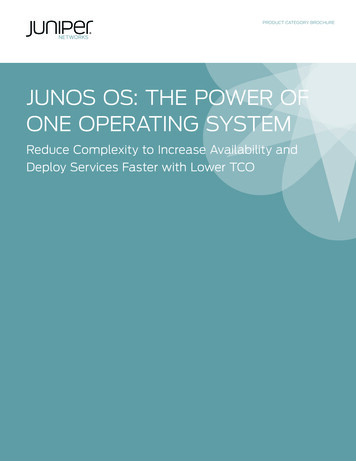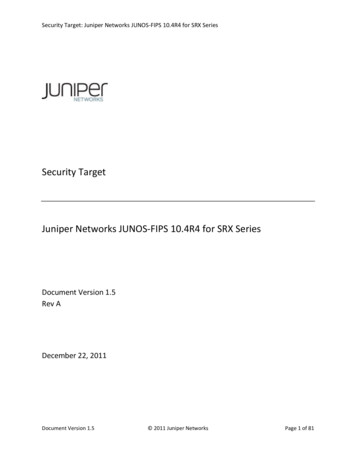
Transcription
Security Target: Juniper Networks JUNOS-FIPS 10.4R4 for SRX SeriesSecurity TargetJuniper Networks JUNOS-FIPS 10.4R4 for SRX SeriesDocument Version 1.5Rev ADecember 22, 2011Document Version 1.5 2011 Juniper NetworksPage 1 of 81
Security Target: Juniper Networks JUNOS-FIPS 10.4R4 for SRX SeriesPrepared For:Prepared By:Juniper Networks, Inc.Apex Assurance Group, LLC1194 North Mathilda Avenue530 Lytton Ave, Ste. 200Sunnyvale, CA 94089Palo Alto, CA his document provides the basis for an evaluation of a specific Target of Evaluation (TOE), JUNOS-FIPS10.4R4 for SRX Series. This Security Target (ST) defines a set of assumptions about the aspects of theenvironment, a list of threats that the product intends to counter, a set of security objectives, a set ofsecurity requirements and the IT security functions provided by the TOE which meet the set ofrequirements.Document Version 1.5 2011 Juniper NetworksPage 2 of 81
Security Target: Juniper Networks JUNOS-FIPS 10.4R4 for SRX SeriesTable of Contents1Introduction . 51.1ST Reference .51.2TOE Reference .51.3About This ST Document .51.3.1 Document Organization .51.3.2 Document Conventions .61.3.3 Document Terminology .61.4TOE Overview .71.5TOE Description .71.5.1 Logical Boundary .122Conformance Claims. 142.1CC Conformance Claim .142.2PP Claim .142.3Package Claim .142.4Conformance Rationale .143Security Problem Definition . 153.1Threats .153.2Organizational Security Policies .173.3Assumptions .184Security Objectives . 194.1Security Objectives for the TOE .194.2Security Objectives for the Operational Environment .204.3Statement of Threats Consistency .214.4Statement of Organizational Security Policies Consistency.244.5Statement of Assumptions Consistency .254.6Statement of Security Objectives for the TOE Consistency .264.7Statement of Security Objectives for the Operational Environment Consistency.295Extended Components Definition . 325.1IDS Class .325.1.1 IDS SDC.1 System Data Collection .325.1.2 IDS ANL.1 Analyzer Analysis .335.1.3 IDS RDR.1 Restricted Data Review (EXT) .345.1.4 IDS RCT.1 – Analyzer React .355.1.5 IDS STG.1 Guarantee of System Data Availability .355.1.6 IDS STG.2 Prevention of System Data Loss .365.2FAU Class .365.2.1 FAU STG EXT.1 External Audit Trail Storage .366Security Requirements . 386.1Security Functional Requirements .386.1.1 Security Audit (FAU) .396.1.2 Cryptographic Support (FCS) .426.1.3 Information Flow Control (FDP) .44Document Version 1.5 2011 Juniper NetworksPage 3 of 81
Security Target: Juniper Networks JUNOS-FIPS 10.4R4 for SRX Series6.1.4 Identification and Authentication (FIA) .476.1.5 Security Management (FMT) .486.1.6 Protection of the TOE Security Functions .506.1.7 Traffic Analysis Component Requirements.506.2Statement of Security Requirements Consistency .516.3Security Functional Requirements Rationale .536.3.1 Sufficiency of Security Requirements .536.3.2 CC Component Hierarchies and Dependencies .566.4Security Assurance Requirements .576.5Security Assurance Rationale .587TOE Summary Specification . 597.1Traffic Analysis and Audit .597.2Cryptographic Support .627.3Information Flow Control .667.4Identification and Authentication .687.5Security Management .698Appendices . 728.1References .728.2Glossary .728.3Acronyms .78Document Version 1.5 2011 Juniper NetworksPage 4 of 81
Security Target: Juniper Networks JUNOS-FIPS 10.4R4 for SRX Series1 IntroductionThis section identifies the Security Target (ST), Target of Evaluation (TOE), Security Target organization,document conventions, and terminology. It also includes an overview of the evaluated products.1.1 ST ReferenceST TitleSecurity Target: Juniper Networks JUNOS-FIPS 10.4R4 for SRX SeriesST Revision1.5ST Publication DateDecember 22, 2011AuthorApex Assurance Group1.2 TOE ReferenceTOE ReferenceJuniper Networks JUNOS-FIPS 10.4R4 for SRX Series1.3 About This ST Document1.3.1 Document OrganizationThis Security Target follows the following format:SECTION1TITLEIntroduction2Conformance Claims3Security ProblemDefinitionSecurity Objectives456Security RequirementsTOE SummarySpecification789RationaleAudit EventsAppendicesDESCRIPTIONProvides an overview of the TOE and defines the hardware andsoftware that make up the TOE as well as the physical and logicalboundaries of the TOELists evaluation conformance to Common Criteria versions,Protection Profiles, or Packages where applicableSpecifies the threats, assumptions and organizational securitypolicies that affect the TOEDefines the security objectives for the TOE/operationalenvironment and provides a rationale to demonstrate that thesecurity objectives satisfy the threatsContains the functional and assurance requirements for this TOEIdentifies the IT security functions provided by the TOE and alsoidentifies the assurance measures targeted to meet theassurance requirementsDemonstrates traceability and internal consistencyTOE audit events are listed hereSupporting materialTable 1 – ST Organization and Section DescriptionsDocument Version 1.5 2011 Juniper NetworksPage 5 of 81
Security Target: Juniper Networks JUNOS-FIPS 10.4R4 for SRX Series1.3.2 Document ConventionsThe notation, formatting, and conventions used in this Security Target are consistent with those used inCommon Criteria version 3.1. Selected presentation choices are discussed here to aid the Security Targetreader. The Common Criteria defines several operations that can be performed on functionalrequirements, including assignment, selection, refinement and iteration.The following applies to the operations performed by the Security Target author; operations performedby Protection Profile authors are not subject to these conventions. The assignment operation is used to assign a specific value to an unspecified parameter, such asthe length of a password. An assignment operation is indicated by showing the value in blue textand in square brackets, i.e. [assignment value(s)]. The selection operation is picking one or more items from a list in order to narrow the scope of acomponent element. A selection operation is indicated by showing the value in italics and insquare brackets, i.e. [selection value(s)]. An assignment within a selection is indicated by showing the value in bold italics and in squarebrackets, i.e. [selected-assignment]. The refinement selection allows the addition of details or the narrowing of requirementscomponents. A refinement selection is indicated by showing the value in bold text, i.e.refinement value(s). Iterated functional and assurance requirements are given unique identifiers by appending to thebase requirement component and element identifiers from the Common Criteria an iterationnumber inside parenthesis, for example, FMT MTD.1(1) and FMT MTD.1(2) refer to separateinstances of the FMT MTD.1 security functional requirement component, where thecorresponding requirement elements would be identified as FMT MTD.1.1(1), FMT MTD.1.1(2), and FMT MTD.1.1, respectively. National Information Assurance Partnership (NIAP) interpretations are used and are presentedwith the text string “NIAP” and the NIAP interpretation number as part of the requirementidentifier (e.g., FAU GEN.1-NIAP-0429 for Audit data generation). In this document, extended requirements are indicated with the text string “(EXP)” following thecomponent name. All the extended requirements are derived from the Protection Profiles citedin Section 2. This Security Target relies on the extended component definitions in the ProtectionProfiles in Section 2.1.3.3 Document TerminologySee Section 9.2 for the Glossary.Document Version 1.5 2011 Juniper NetworksPage 6 of 81
Security Target: Juniper Networks JUNOS-FIPS 10.4R4 for SRX Series1.4 TOE OverviewThe Target of Evaluation (TOE) includes the following secure router products running JUNOS-FIPS10.4R4: SRX100, SRX210, SRX220, SRX240, SRX650, SRX3400, SRX3600, SRX5600, and SRX5800. The TOEincludes a FIPS 140-2 validated cryptographic module.These network devices provide the following basic services in the evaluated configuration: VPN Routing — securely forwarding data packets along networks in accordance with one ormore routing protocols Firewalling — applying access rules to control connectivity between two or more networkenvironments Intrusion detection and prevention — monitoring and analyzing a set of IT system resources forpotential vulnerabilities or misuse and taking action upon detection of potential vulnerabilities.1.5 TOE DescriptionThe TOE consists of the following components:1. Appliances: purpose-built appliances deployed at branch and remote locations in the network toprovide all-in-one secure WAN connectivity, IP telephony, and connection to local PCs andservers via integrated Ethernet switching.2. JUNOS 10.4: an operating system for security appliances.Traffic that enters and exits the secure routers running JUNOS Software is processed according tofeatures the customer configures, such as packet filters, security policies, and pre-configured filters forcommon attacks (also known as “screens”). For example, the software can determine: Whether the packet is allowed into the device Which firewall screens to apply to the packet The route the packet takes to reach its destination Which class of service (CoS) to apply to the packet, if any Whether to apply Network Address Translation (NAT) to translate the packet’s IP address Whether the packet requires an Application Layer Gateway (ALG)Packets that enter and exit the secure router undergo both packet-based and flow-based processing.Document Version 1.5 2011 Juniper NetworksPage 7 of 81
Security Target: Juniper Networks JUNOS-FIPS 10.4R4 for SRX Series Flow-based packet processing treats related packets, or a stream of packets, in the same way.Packet treatment depends on characteristics that were established for the first packet of thepacket stream, which is referred to as a flow. This is also known as “stateful packet processing”. Packet-based, or stateless, packet processing treats packets discretely. Each packet is assessedindividually for treatment.Interfaces act as a doorway through which traffic enters and exits the secure router. Many interfacescan share exactly the same security requirements; however, different interfaces can also have differentsecurity requirements for inbound and outbound data packets. Interfaces with identical securityrequirements can be grouped together into a single security zone.Security zones are the building blocks for policies; they are logical entities to which one or moreinterfaces are bound. Security zones provide a means of distinguishing groups of hosts (user systemsand other hosts, such as servers) and their resources from one another in order to apply differentsecurity measures to them.Security zones have the following properties: Interfaces — A list of interfaces in the zone. Policies — Active security policies that enforce rules for the transit traffic, in terms of whattraffic can pass through the firewall, and the actions that need to take place on the traffic as itpasses through the firewall. Screens — A Juniper Networks stateful firewall secures a network by inspecting, and thenallowing or denying, all connection attempts that require passage from one security zone toanother. For every security zone, and the management zone, a set of predefined screen optionscan be enabled that detect and block various kinds of traffic that the device determines aspotentially harmful. This is known as “Reconnaissance Deterrence”. Address books—Contains the IP address or domain names of hosts and subnets whose traffic iseither permitted, denied, encrypted, or user-authenticatedTo secure all connection attempts, JUNOS uses a dynamic packet-filtering method known as statefulinspection. Using this method, JUNOS identifies various components in the IP packet and TCP segmentheaders—source and destination IP addresses, source and destination port numbers, and packetsequence numbers—and maintains the state of each TCP session and pseudo UDP session traversing thefirewall. JUNOS also modifies session states based on changing elements such as dynamic port changesor session termination.When a responding TCP packet arrives, JUNOS software compares the information reported in itsheader with the state of its associated session stored in the inspection table. If they match, theresponding packet is allowed to pass the firewall. If the two do not match, the packet is dropped.Document Version 1.5 2011 Juniper NetworksPage 8 of 81
Security Target: Juniper Networks JUNOS-FIPS 10.4R4 for SRX SeriesJUNOS Screen options secure a zone by inspecting, then allowing or denying, all connection attemptsthat require crossing an interface bound to that zone. JUNOS then applies firewall policies, which cancontain content filtering and IDS components, to the traffic that passes the Screen filters.The JUNOS IDS system selectively enforces various attack detection and prevention techniques onnetwork traffic traversing the secure routers. It enables the definition of policy rules to match trafficbased on a zone, network, and application, and then take active or passive preventive actions on thattraffic.The signature database is stored on the secure router and contains definitions of predefined attackobjects and groups. These attack objects and groups are designed to detect known attack patterns andprotocol anomalies within the network traffic. In response to new vulnerabilities, Juniper Networksperiodically provides a file containing attack database updates on the Juniper web site.The TOE supports IPsec to provide confidentiality and integrity services for network traffic transmittedbetween TOE devices and for traffic transmitted from a TOE device to an external IT system (e.g., a peerrouter).The following figure shows a typical IPsec architecture:Figure 1 – Typical IPsec ConfigurationThe JUNOS Software performs all IPsec operations, and supports the Authentication Header (AH) andEncapsulating Security Payload (ESP) security protocols, the set-up and processing of SecurityAssociations (SAs), the Internet Key Exchange (IKE) protocol, and the IPsec algorithms for authenticationand encryption. JUNOS also enforces MAC address filtering, where the interface on a router may beconfigured to accept packets only from specified MAC addresses.Juniper Networks security devices accomplish routing through a process called a virtual router (VR). Asecurity device divides its routing component into two or more VRs with each VR maintaining its own listof known networks in the form of a routing table, routing logic, and associated security zones.Document Version 1.5 2011 Juniper NetworksPage 9 of 81
Security Target: Juniper Networks JUNOS-FIPS 10.4R4 for SRX SeriesThe JUNOS software Intrusion Detection and Prevention (IDP) policy enables the selective enforcementof various attack detections and prevention techniques on network traffic. It allows the definition ofpolicy rules to match a section of traffic based on a zone, or network and then takes active or passiveactions on that traffic. The TOE analyzes traffic for signature, Protocol Anomaly, Backdoor, TrafficAnomaly, Layer 2, and Denial of Service (DoS) attacks and, upon detection, can log the event, drop thepacket, or block the originating address.The TOE may be configured in either a transparent mode or an active gateway mode for IDP functions.When deployed as an active gateway, the TOE uses a policy to control what action to take when anattack is detected (e.g., log the event, or block/drop any identified malicious packets). When deployed intransparent mode, the TOE only detects and logs attacks. The TOE detection and prevention capabilitiesare rule-based, so rules can be specified within a Security Policy to define when and how packets orconnections are dropped; the Security Policy configures the Sensor to log, send alarms, and even dropsuspicious traffic.The TOE is managed and configured via Command Line Interface.Each secure router is a hardware device that protects itself largely by offering only a minimal logicalinterface to the network and attached nodes. JUNOS is a special purpose OS that provides no generalpurpose programming capability. All network traffic from one network zone to another or between twonetworks within the same network zone passes through the TOE. The TOE also preserves itsconfiguration for a trusted recovery in the event that the configuration has been modified and not savedor if the security router has been ungracefully shutdown. The TOE additionally protects the session tableby enforcing destination-based session limits and applying procedures to limit the lifetime of sessionswhen the session table reaches the defined watermark.The TOE is a combined hardware/software TOE and is defined as JUNOS-FIPS 10.4R4 for SRX Series. TheTOE boundary is shown below:Document Version 1.5 2011 Juniper NetworksPage 10 of 81
Security Target: Juniper Networks JUNOS-FIPS 10.4R4 for SRX SeriesFigure 2 – TOE BoundaryIn order to comply with the evaluated configuration, the following hardware and software componentsshould be used:TOE COMPONENTTOE HardwareTOE SoftwareVERSION/MODEL NUMBERSRX100, SRX210, SRX220, SRX240, SRX650, SRX3400, SRX3600, SRX5600, SRX5800JUNOS-FIPS 10.4R4Table 2 – Evaluated Configuration for the TOEThe TOE interfaces are comprised of the following:1. Network interfaces, which receive traffic for analysis and pass traffic for routing/VPN functionsand transmission of generated audit data to an external IT entity.2. Management interfaces exercised via CLI.The following ports and services are excluded from the evaluation: 465/tcp (smtps - secure Simple Mail Transport Protocol) 636/tcp (ldaps - Secure Lightweight Directory Access Protocol) 989/tcp (ftps-data - Secure File Transfer Protocol Data port)Document Version 1.5 2011 Juniper NetworksPage 11 of 81
Security Target: Juniper Networks JUNOS-FIPS 10.4R4 for SRX Series 992/tcp (telnets - Secure TELNET Protocol) 443/tcp (supports management via J-Web GUI) 123/udp (Network Time Protocol)The following options are not part of the evaluated configuration: TACACS RADIUS1.5.1 Logical BoundaryThis section outlines the boundaries of the security functionality of the TOE; the logical boundary of theTOE includes the security functionality described in the following sections.TSFTraffic Analysis and AuditCryptographic SupportUser DataProtection/InformationFlow ControlIdentification andAuthenticationDocument Version 1.5DESCRIPTIONJUNOS auditable events are stored in the syslog files. Auditable eventsinclude start-up and shutdown of the audit functions, network traffic events,authentication events, and service requests, as well as the events listed inTable 18 – Auditable Events. Audit records include the date and time, eventtype, username, and the outcome of the event (success or failure). IDS auditrecords also include component identity. The TOE provides the capability ofanalyzing potential intrusions via signature analysis, which uses patternscorresponding to known attacks, and by detecting protocol anomalies. TheAdministrator can review and delete audit data and IDS audit data. Searchand sort facilities are provided via tools in the IT Environment, along with theability for the appropriate administrator to determine how exhaustion ofspace for audit records is handled. In conjunction with the audit capabilities,the TOE provides an alarm mechanism that provides immediate notificationof potential security violations and potential intrusions.The TOE includes a baseline cryptographic module that providesconfidentiality and integrity services for authentication and for protectingcommunications with adjacent systems. The cryptographic module fulfillsthe requirements of FIPS 140-2 Overall Level 2.The TOE is designed to forward network packets (i.e., information flows)from source network entities to destination network entities based onavailable routing information. This information is either provided directly byTOE users or indirectly from other network entities (outside the TOE)configured by the TOE users. The TOE has the capability to regulate theinformation flow across its interfaces; traffic filters can be set in accordancewith the presumed identity of the source, the identity of the destination, thetransport layer protocol, the source service identifier, and the destinationservice identifier (TCP or UDP port number).The TOE requires users to provide unique identification and authenticationdata before any administrative access to the system is granted. The devicesalso require that applications exchanging information with them successfully 2011 Juniper NetworksPage 12 of 81
Security Target: Juniper Networks JUNOS-FIPS 10.4R4 for SRX SeriesTSFSecurity ManagementDESCRIPTIONauthenticate prior to any exchange. This covers all services used to exchangeinformation, including telnet, File Transfer Protocol (FTP), Secure Shell (SSH),and Secure Socket Layer (SSL); both telnet and FTP are out of scope.Authentication services are handled internally by user-selected passwords.Note that in support of FIPS 140-2 compliance, external authenticationservers are outside the scope of the evaluation.The TOE provides an Administrator role that is responsible for: the configuration and maintenance of cryptographic elementsrelated to the establishment of secure connections to and from theevaluated product the regular review of all audit data; all administrative tasks (e.g., creating the security policy).The devices are managed through a Command Line Interface (CLI). The CLI isaccessible through remote administrative session, or via a local terminalconsole.Table 3 – Logical Boundary1.5.1.1 TOE GuidanceThe following guidance documentation will be provided as part of the TOE: Operational User Guidance and Preparative Procedures Supplement: Juniper Networks JUNOSFIPS 10.4R4 for SRX Series11.5.1.2 IT EnvironmentThe TOE boundary does not include the following IT Environment Components:1. Hardware and software for the syslog server. Note that the syslog server shall be able toperform searches and sorting of Firewall audit data based on: presumed subject address, rangesof dates, ranges of times, and ranges of addresses.2. Hardware platforms for the Management Platform, which can be any of the following: Windows 2000 SP4, 2003 SP2, XP SP2 or later Redhat Linux (2.6 Kernel) or later Solaris (SPARC) 8 and 10 or later1Note this document contains references to a broader set of public documentation available from Juniper’sTechpubs website (http://www.juniper.net/techpubs)Document Version 1.5 2011 Juniper NetworksPage 13 of 81
Security Target: Juniper Networks JUNOS-FIPS 10.4R4 for S
ST Title Security Target: Juniper Networks JUNOS-FIPS 10.4R4 for SRX Series ST Revision 1.5 ST Publication Date December 22, 2011 Author Apex Assurance Group 1.2 TOE Reference TOE Reference Juniper Networks JUNOS-FIPS 10.4R4 for SRX Series 1.3 About This ST Document 1.3.1 Document Organization This Security Target follows the following format:

